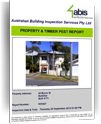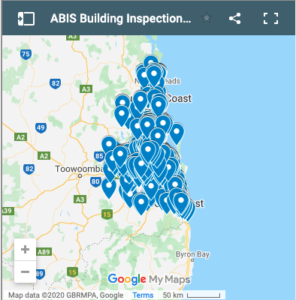Rising Damp in masonry occurs when ground water rises up the walls of a building by capillary action.
This is traditionally prevented by the insertion of a damp proof course during construction. The damp proof course is positioned level with the underside of the floor to form an impermeable barrier.
Symptoms appear as localized dampness in linear or patch form or widespread dampness which is highlighted in the lower sections of internal walls and the internal face of external walls. Internal plaster finishes may be damp, blistered or discoloured with “tide marks”. Surface patches of water-soluble salts may be residue after moisture evaporates. Skirting boards may be affected by fungal decay, and if the floor is a suspended timber floor it may also be weak near the wall. Where the rising damp contains high concentrations of salts this may also cause extensive spalling and fretting of masonry where the osmotic pressure of “crypto-efflorescence” causes moisture to be continually drawn higher up the wall.
Damp proof (dpc) courses block this upward movement of moisture but are sometimes ineffective. These usually take the form of a sheet membrane barrier built into a bed joint. As their purpose is to limit the rise of dampness, to be effective, they must be continuous and extend across the full width of the wall. This means they must extend right out to the face of the brickwork and if there is any applied finish, they must extend out to the face of that. A set back of as little as 5mm is more than enough to allow damp to extend several courses above the dpc level and salt into the higher parts of the wall.
The Building Code of Australia and Australian Standard AS3700 Masonry Code require dpcs to be placed through the full thickness of the base of walls below floor level to form an impervious layer that keeps rising dampness out of the interior of the house to prevent lifting of tiles, and deterioration of walling, furnishings and floor finishes. Where rising damp has caused mortar in external face brickwork to fret, the appearance of the brickwork can be restored by repointing the joints.
Disrupted Damp-Proof Course
Movement to which all structures are subjected sometimes cause brittle dpcs to crack. The result is usually a local patch of efflorescence, fretting or timber rot. In case of isolated patches of rising damp, local insertion of a new dpc followed by treatment of deteriorated plaster will usually be appropriate.
Plaster that has been wet because of rising damp will have reacted with salts in the rising water to create hygroscopic compounds that attract further water from the air into the plaster. Because of this, a completely drywall will not be created unless contaminated plaster is replaced. Time should be allowed between repairing the damp problem and replacing the plaster to allow the rising damp moisture to evaporate off the bricks, draw the undesirable salts into the plaster layer and thus enable that salt to be removed with the plaster.
The d.p.c. no longer copes
Change to the conditions at the base of the wall that put increased pressure on what was always a deficient dpc (e.g mortar dpc with inadequate waterproofer compound mixed into it) is the most common reason for a building to develop a dampness problem.
The d.p.c. is bridged
If a membrane dpc is not placed through the full thickness of the wall, moisture will be allowed to cross a mortar “bridge” at the face of the mortar joint. This problem is most commonly seen in older houses where a bituminous felt membrane was used that is less than the full width of the wall. A similar problem can occur when older face brickwork or blockwork is rendered with the render bridging the dpc. Alternatively, a concrete path or gardens may be located above dpc level and sloped towards the wall. Dampness caused by poorly-laid paths may be resolved by preferably, rebuilding the path below the dpc, and sloping it away from the house or installing a spoon or enclosed drain in the path adjacent to the wall and connecting it to the stormwater.
Another bridging problem can be created where mortar droppings in the base of the wall cavity build up and cover the stepped flashing/dpc providing a passage for dampness from the outer to the inner leaf of the wall. A local dpc insertion above the damp patch together with the internal application of a waterproof coating of the masonry below the new dpc and then replastering will usually resolve this problem.
Damp proof bridging is a problem usually associated with new buildings and is caused by:
- Filling in the cavity above the level of the damp proof course e.g. mortar droppings and brickbats
- Earth where street levels have been raised and gardens cover sub-floor, reducing ventilation
- Concrete paths and verandahs laid without membranes are above the damp proof course
- Rendering over the damp proof course so that dampness may bypass the damp proof course
- Re-pointing decayed mortar joints at the damp proof course level without waterproofing additives
- Additions with the failure of the damp proof course to meet up between the different sections of work or a complete lack of damp proof course in new work being keyed into existing work above the existing damp proof course.
- Existing damp proof courses may be fractured by foundation movement or hydrostatic pressure from a leaking drain or a raised street level.
- Rising damp in slab-on-ground buildings is evident in the form of patches on the slab surface or in the floor coverings causing decay, lifting or arching and frequently results from faulty slab construction caused by a lack of vapour barrier beneath the slab or adequate subsoil drainage.
A new damp-proof course may be installed by:
Physically inserting a new membrane
A mortar bed-course, at a level below the lowest floor, framing member is cut out and a new dpc membrane is then inserted into the resulting horizontal gap. This technique is now mostly associated with a patented method using a plastic bag as the membrane which is inserted into the joint and then pumped full of a quick-setting mortar to ensure support.
Creating a chemical d.p.c.
A horizontal row of holes is drilled into the bricks or mortar which is injected with a chemical under pressure to impregnate a band of bricks and mortar to create a moisture resistant layer.
*A qualified and licensed plumber, waterproofer or damp proofing professional should be consulted where water/moisture related problems are suspected.
Wikipedia Entry for Damp Proofing





